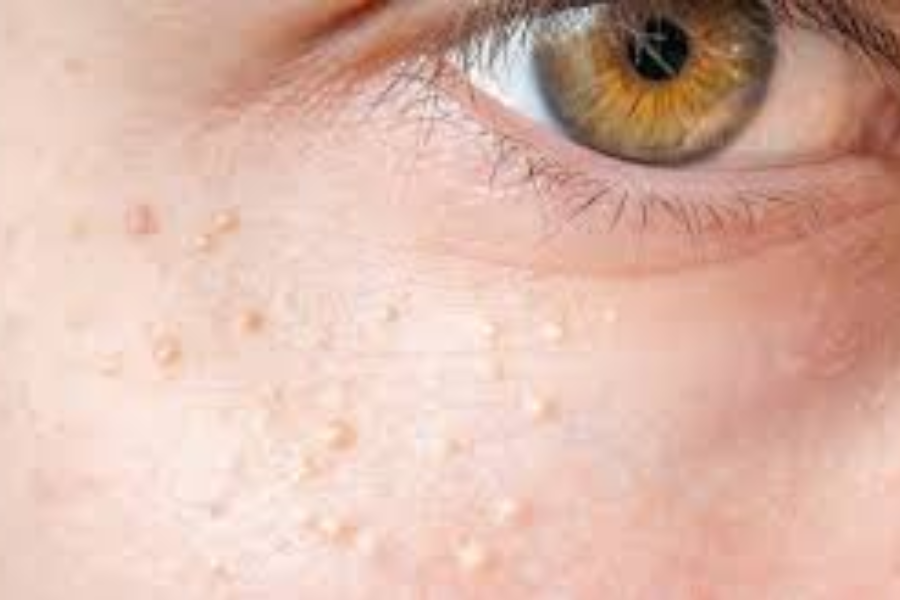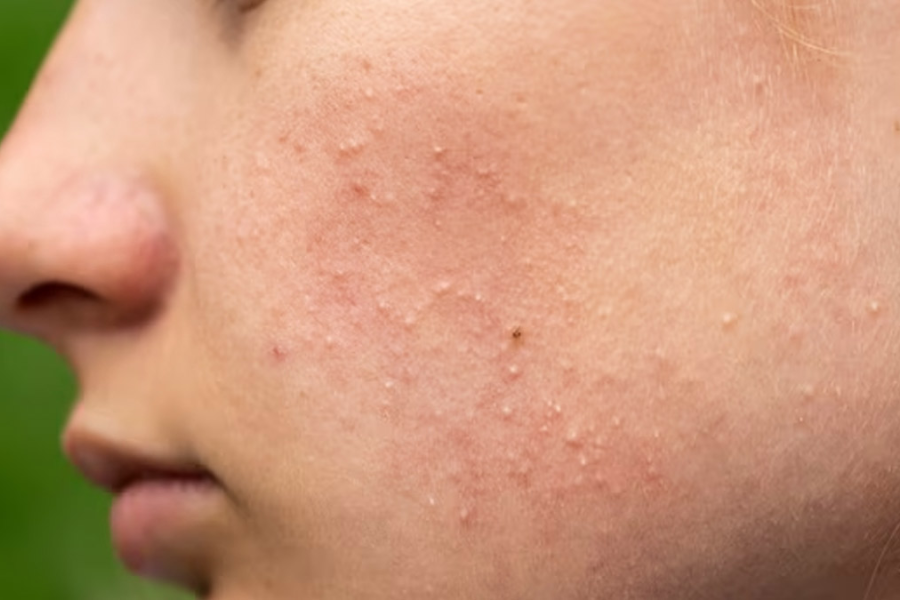Our skin frequently uncovers insights concerning our general prosperity and wellbeing, yet it can likewise introduce difficulties that frustrate us.
One such test is the presence of milia, generally known as “milk spots” or “oil seeds.”
These little, white or yellowish knocks, however commonly innocuous, can be very irksome and tastefully disappointing.
This article will dive into the universe of milia, investigating what they are, the reason they happen, and how to oversee them actually.
What Are Milia?
Milia are small, effortless blisters that manifest as white or yellowish knocks on the skin.
Not at all like skin break out, milia don’t have an opening or pore, making them impervious to regular crushing or popping.
These knocks are framed when dead skin cells become caught just underneath the skin’s surface.
Symptoms and Identification
Milia looks like little skin knocks the size of pinheads. They can differ in variety from white to yellowish and show up as minuscule pearls or seeds on the skin.
These knocks can happen anyplace on the body however are most usually tracked down on the face, especially around the cheeks, eyes, nose, and brow. Incidentally, they might show up in the upper middle.
Common Sites on the Body
While milia can foster anyplace on the body, certain regions are more inclined to these knocks.
The face, particularly the cheekbones, eyelids, nose, and brow, are normal locales.
Inconsistently, milia can likewise be tracked down on the upper arms, upper mid-region, and genital region.
Causes of Milia
Our skin normally peels itself by shedding old skin cells to clear a path for new, sound cells.
Be that as it may, when old skin cells don’t shed as expected, they become caught under the skin’s surface, solidify, and structure little sores known as milia.
Factors Contributing to Milia Development
Several factors can contribute to the formation of milia, including:
Overproduction and Trapping of Keratin: Excess keratin, a protein found in the skin, can become trapped beneath the skin’s surface, leading to the formation of milia.
Damage to Oil Glands or Sweat Ducts: Skin trauma from burns, sun exposure, or other injuries can damage oil glands and sweat ducts, resulting in milia.
Clogged Glands or Ducts: Clogged pores filled with oil and dead skin cells can develop into milia.
Cosmetics and Skincare Products: Heavy moisturizers and creams that are not suitable for your skin type can clog pores and contribute to milia.
Genetics: A genetic predisposition may make some individuals more prone to developing milia.
Types of Milia
Milia can be categorized based on their primary causes and characteristics:
Primary Milia
Primary milia appear spontaneously when dead skin cells become trapped under the skin’s surface. Types of primary milia include:
Congenital Milia: Common in newborns, these cysts typically appear on the face, especially the nose, and usually resolve on their own within a few weeks.
Benign Primary Milia in Children and Adults: These can develop spontaneously on various parts of the body, including the eyelids, cheeks, forehead, and genital area.
Milia en Plaque: A rare type that affects primarily women aged 40 to 70. This form involves clusters of milia on a patch of skin that can grow to several centimeters in size.
Multiple Eruptive Milia: This rare condition causes groups of itchy cysts to form on the face, upper arms, and upper abdomen.
Genodermatosis-associated Milia: Linked to genetic skin conditions like Brooke-Spiegler syndrome, pachyonychia congenita type 2, and basal cell nevus syndrome.
Secondary Milia
Secondary milia occur after skin injuries, medication use, or as a result of skin diseases. Types of secondary milia include:
Disease-associated Milia: Occur with blistering skin diseases like epidermolysis bullosa.
Medication-associated Milia: Form due to long-term use of topical steroids or nonsteroidal anti-inflammatory drugs (NSAIDs).
Trauma-associated Milia: Common after skin grafts, burns, or radiotherapy.
Diagnosing Milia
Milia are normally analyzed through a careful visual assessment by a dermatologist.
They give close consideration to the size, shape, and shade of the knocks and may utilize amplifying instruments for a nearer examination.
A nitty gritty clinical history, including medicine use and skincare routine, is likewise thought of.
At times, an infinitesimal assessment of a tissue test (biopsy) might be performed to affirm the conclusion.
Treating Milia
Milia are for the most part innocuous and frequently resolve all alone without treatment.
In any case, there are a few strategies accessible for the people who wish to eliminate milia for corrective reasons or because of uneasiness.
Professional Treatments
Extraction: Dermatologists use a tiny needle or scalpel to make a small cut in the skin and apply pressure to remove the milia, a process known as deroofing.
Chemical Peels: These exfoliants break down dead skin cells, helping to remove milia and reveal healthier skin cells underneath. Common ingredients include glycolic acid, lactic acid, and salicylic acid.
Topical Retinoids: Derived from vitamin A, retinoids stimulate collagen production and accelerate cell turnover, helping to reduce milia. Examples include tretinoin (Retin-A), adapalene (Differin), and tazarotene (Tazorac).
Home Remedies and Prevention
While it is not advisable to attempt to remove milia at home by popping or squeezing, there are preventive measures and home treatments that can help manage and reduce the risk of milia development:
Regular Exfoliation: Use gentle exfoliants to help remove dead skin cells and prevent pore blockages.
Proper Skincare Routine: Wash your face daily with warm water and a gentle cleanser. Avoid heavy, oil-based skincare products that can clog pores.
Sun Protection: Use a broad-spectrum sunscreen with at least SPF 30 to protect your skin.
from sun damage
Avoid Overuse of Steroids: Limit the use of topical steroids unless prescribed by a healthcare professional.
The Ultimate Milia Detox: A Skincare Regimen
For those hoping to adopt an extensive strategy to treating and forestalling milia, A definitive Milia Detox is a seven-day routine intended to cleanse your skin and target milia.
This routine integrates strong fixings, for example, salicylic corrosive, glycolic corrosive, and retinol to break up pollutants and unclog pores.
Day-by-Day Guide
Day 1: Cleanse and Prep
- Start with a gentle foaming cleanser to thoroughly cleanse your skin, removing makeup and impurities.
Day 2: Exfoliate and Renew
- Use an exfoliating scrub to slough away dead skin cells and unclog pores, focusing on areas prone to milia.
Day 3: Treat and Target
- Apply a targeted treatment serum containing salicylic acid to problem areas. Allow it to absorb fully before applying moisturizer.
Day 4: Nourish and Hydrate
- Use a lightweight moisturizer enriched with hydrating ingredients to maintain skin balance and nourishment.
Day 5: Rejuvenate and Revitalize
- Pamper your skin with a rejuvenating face mask infused with antioxidants and vitamins to replenish lost nutrients.
Day 6: Protect and Shield
- Apply a broad-spectrum sunscreen to protect your skin from UV exposure and prevent further skin damage.
Day 7: Glow and Shine
- Celebrate your progress and enjoy your renewed, radiant skin. Continue the regimen to maintain results and prevent recurrence of milia.
Frequently Asked Questions
Can milia be painful?

- Milia are typically not painful and are more of a cosmetic concern.
Is it safe to pop milia?
- No, attempting to pop milia can irritate the skin and lead to infection. Professional assistance is recommended.
Do milia go away on their own?
- Yes, milia often resolve on their own without treatment, though some may persist for a longer time.
What are the treatment options for milia?
- Treatment options include chemical peels, topical retinoids, professional extraction, and regular exfoliation.
Are there home remedies for milia?
- Gentle exfoliation and proper skin care can help manage milia, but professional diagnosis and treatment are recommended for persistent cases.
Conclusion
Milia, however by and large innocuous, can be an unwanted expansion to your skin. Grasping the causes, types, and treatment choices can help you oversee and forestall these little pimples.
Whether you pick proficient medicines or follow a committed skincare routine like A definitive Milia Detox, accomplishing clear and brilliant skin is reachable.
Counsel a dermatologist to decide the best strategy for your particular necessities and partake in the certainty that accompanies solid, gleaming skin.
Understanding and Treating Milia: A Comprehensive Guide
Facts:
1.Definition: Milia are small, painless blisters that appear as white or yellowish bumps on the skin.
2.Formation: These bumps form when dead skin cells become trapped beneath the skin’s surface.
3.Appearance: Milia resemble tiny pearls or seeds and can appear anywhere on the body, commonly on the face.
4.Causes: Factors include overproduction of keratin, damage to oil glands or sweat ducts, clogged pores, inappropriate skincare products, and genetics.
5.Types
Primary Milia: Spontaneous, including congenital milia in newborns and milia en plaque.
Secondary Milia: Resulting from skin injuries, medication use, or skin diseases.
6.Diagnosis: Usually diagnosed through visual examination by a dermatologist; sometimes a biopsy is needed.
7.Treatment Options: Professional extraction, chemical peels, and topical retinoids.
8.Home Care: Regular exfoliation, proper skincare, and sun protection can help manage and prevent milia.
Summary:
Milia, often referred to as “milk spots” or “oil seeds,” are small, white or yellowish bumps that appear on the skin. These bumps, although generally harmless, can be aesthetically displeasing. Milia form when dead skin cells become trapped beneath the skin’s surface, creating small, painless blisters. They are most commonly found on the face, particularly around the cheeks, eyes, nose, and forehead.
Several factors contribute to the development of milia, including overproduction of keratin, damage to oil glands, clogged pores, unsuitable skincare products, and genetics. There are two main types of milia: primary milia, which appear spontaneously, and secondary milia, which occur after skin injuries or due to certain medications.
Diagnosis is typically made through a visual examination by a dermatologist, who may also consider the patient’s medical history and skincare routine. While milia often resolve on their own, treatment options such as professional extraction, chemical peels, and topical retinoids are available for those who seek cosmetic improvement.
A dedicated skincare routine, including regular exfoliation, proper skin care, and sun protection, can help prevent and manage milia. For a comprehensive approach, the “Ultimate Milia Detox” offers a seven-day regimen targeting milia through cleansing, exfoliation, and targeted treatments.
Frequently Asked Questions:
1.Can milia be painful?
- Milia are typically not painful and are more of a cosmetic concern.
2.Is it safe to pop milia?
- No, attempting to pop milia can irritate the skin and lead to infection. Professional assistance is recommended.
3.Do milia go away on their own?
- Yes, milia often resolve on their own without treatment, though some may persist for a longer time.
4.What are the treatment options for milia?
- Treatment options include chemical peels, topical retinoids, professional extraction, and regular exfoliation.
5.Are there home remedies for milia?
- Gentle exfoliation and proper skin care can help manage milia, but professional diagnosis and treatment are recommended for persistent cases.

Leave a Reply